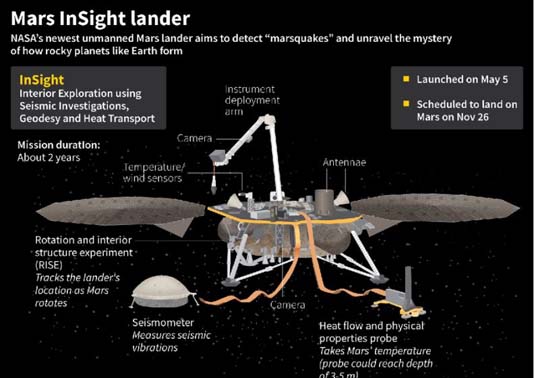LOS ANGELES, Nov 26, 2018 (BSS/AFP) – NASA’s top scientists admitted to
sleepless nights, sweaty palms, stomach aches and moments of pure terror as
their $993 million Mars Insight spacecraft approaches a high-drama finale
Monday: landing on Mars.
Mars Insight’s goal is listen for quakes and tremors as a way to unveil the
Red Planet’s inner mysteries, how it formed billions of years ago, and by
extension, how other rocky planets like Earth took shape.
The unmanned spacecraft launched nearly seven months ago, and is NASA’s
first to attempt to touch down on Earth’s neighboring planet since the
Curiosity rover arrived in 2012.
More than half of 43 attempts to reach Mars with rovers, orbiters and
probes by space agencies from around the world have failed.
NASA is the only space agency to have made it, and is invested in these
robotic missions as a way to prepare for the first Mars-bound human explorers
in the 2030s.
“We never take Mars for granted. Mars is hard,” said Thomas Zurbuchen, NASA
associate administrator for the science mission directorate, on Sunday.
– ‘An absolutely terrifying thought’ –
The high drama of the entry, descent and landing phase begins at 11:47 am
(1940 GMT) at NASA’s Jet Propulsion Laboratory in Pasadena, California, home
to mission control for Mars Insight.
A carefully orchestrated sequence — already fully preprogrammed on board
the spacecraft — takes place over the next several minutes, coined “six and
a half minutes of terror.”
Speeding faster than a bullet at 12,300 mph (19,800 kph), the heat-shielded
spacecraft encounters scorching frictions as it enters Mars’ atmosphere.
The heat shield soars to a temperature of 2,700 Fahrenheit (about 1,500
Celsius). Radio signals may be briefly lost.
The heat shield is discarded, the three landing legs deploy, and the
parachute pops out.
“We freefall for just a little bit, which is an absolutely terrifying
thought for me,” said Tom Hoffman, project manager of InSight.
But then, the spacecraft’s thrusters begin to fire, further slowing down
the 800-pound (365 kilogram) spacecraft to a speed of just about 5 mph (8
kph) when it reaches the surface.
Since there is no joystick back on Earth for this spacecraft, and no way to
intervene if anything goes wrong, Hoffman described his emotions as mixed.
“I am completely comfortable and completely nervous at the same time,” he
said.
“We have done everything we can think to make sure we are going to be
successful, but you just never know what is going to happen.”
Hoffman, who is father to a two- and four-year-old, added that has “not
been sleeping that great,” though he said that might because of his
rambunctious toddlers.
But when the first signal arrives at 2001 GMT, hopefully showing that the
lander set itself down, intact and upright, “I am totally going to unleash my
inner four-year-old at that point,” he said.
– Goal: 3D map of inner Mars –
Zurbuchen described InSight as “unique” because the waist-high lander
contains instruments that were contributed by several European space
agencies.
France’s Centre National d’?tudes Spatiales (CNES) made the Seismic
Experiment for Interior Structure (SEIS) instrument, the key element for
sensing quakes.
The German Aerospace Center (DLR) provided a self-hammering mole that can
burrow 16 feet (five meters) into the surface — further than any instrument
before — to measure heat flow.
Spain’s Centro de Astrobiologia made the spacecraft’s wind sensors.
Other significant contributions to the project came from the Space Research
Center of the Polish Academy of Sciences and Astronika in Poland, the Swiss
Institute of Technology in Switzerland, and the Imperial College and Oxford
University in Britain.
Together, these instruments will use physics to study geological processes,
said Bruce Banerdt, InSight’s principal investigator at NASA’s Jet Propulsion
Laboratory.
By listening for tremors on Mars, whether from quakes or meteor impacts or
even volcanic activity, scientists can learn more about its interior and
reveal how the planet formed.
The goal is to map the inside of Mars in three dimensions, “so we
understand the inside of Mars as well as we have come to understand the
outside of Mars,” Banerdt told reporters.
Understanding how Mars formed could reveal more about the processes that
formed Earth, too.



